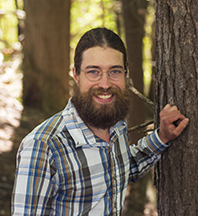Week of March 3, 2024 – March 9, 2024

by David DuBois, Land Steward
Throughout Baltimore Woods you will see flashes of color year round. But through the winter some of the brightest colors frequently take the form of flags and flagging. These small pieces of brightly colored plastic serve an important part of our stewardship work here at Baltimore Woods, but their meaning and value may not be clear as you are hiking by them.
Have you ever wondered what the flags are for? At the most basic level a flag indicates a place that we want to return to and re-find, and marking it with a bright color is a convenient way to do that. It also allows the many staff and volunteers involved with preserve stewardship to communicate about locations and projects throughout the year – and we’d like to help all our visitors better understand the importance of these flags!
The most frequent reason is to mark a plant or a patch of plants that we want to return to and remove. Invasive species control is a major part of keeping native habitats functional, and sometimes we find invasives at a time when control is difficult, such as finding a plant that we’d like to pull when the ground is frozen. These invasive plants are usually marked with pink pin flags or a blue tape flag hanging from the branches. Marking plants and areas this way lets us know where we need to control invasives, and gives us a reference point to follow up on and assess how well invasive control efforts have worked.
Another important reason that we use flags at Baltimore Woods is to track a single plant as it grows. We plant a lot of trees and shrubs and it is important for us to know if the money and time invested in planting trees is worth it. That means we have to re-find the plants we planted and determine if they are succeeding or failing so we can continuously improve our methods. Along the Boundary Trail, for example, there is a patch with 5 colors of pin flags that denote plantings we made on Earth Day of 2021. Each color represents a different species of plant, allowing us to track survival over the years. We have learned that while many of the shrubs have survived and established from that planting, Red Oaks have not. Tracking plantings by memory or using GPS coordinates is possible on a smaller scale, but when we plant hundreds of trees and shrubs every year being able to quickly relocate the survivors and confidently know when a plant has died, flagging becomes a critical tool.
Finally, we also use flagging to delineate research. One such example is a set of seed plots that we set up in 2021 to evaluate the germination rates of understory herbs. To do this we created more than 60 spots where we would monitor for seedlings. Without accurately marking those spots it would be impossible to refind these little circles, especially considering that ¼ of those plots should be intentionally empty as control sites!
Next time you see flagging in Baltimore Woods do not lament that nature is being despoiled by plastic but rather get excited that we are using tools like flagging to better understand how we can efficiently bring back biodiversity and improve habitats. As each research and stewardship project moves forward or wraps up, we collect the flags and tape to be used again as we continue to conserve and restore areas of this beloved preserve.

